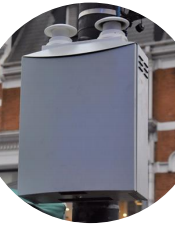Real time monitoring falls into two main categories; reference equivalent and lower cost sensor systems. Reference equivalent stations are often walk-in cabinets, with sophisticated instruments that meet well-defined national standards. Air quality sensors tend to be small, compact, multi pollutant devices. They can be mains, battery or solar powered, and are typically installed in a few hours.
Sensors often provide measurements very frequently, 1-minute averages are common. Sensors which are powered using the sun (solar powered) may reduce how often measurements are taken so enough power is still available when there isn’t much sunshine.
|
Sensors out of the box can be used for very rough screening purposes but ongoing corrections are needed to improve dataset quality. Even then, the data quality may not be to a level suitable for policy and decision making, or for inclusion in local authority LAQM reporting. Sensors typically work for 12 to 24 months, depending on the brand, before requiring maintenance. Maintenance generally comprises of replacement sensor modules, which are plugin. |
Air quality sensors are easily deployed at greater densities than reference stations due to lower price, and ease of installation (hyper-local), compared to reference monitoring. Sensors unit outputs can be added into networks or used by individuals to measure pollution in their local environment.
installation (hyper-local), compared to reference monitoring. Sensors unit outputs can be added into networks or used by individuals to measure pollution in their local environment.
Further information on these types of monitoring can be found on the Monitoring page. It should be noted that real world monitoring sensor datasets are likely to be misleading without ongoing maintenance, adjustments and corrections, most are susceptible to the effects of changes in
ambient temperature and humidity, which can have a large effect on data quality.
Recently some commercial sensor units have gained MCERTS indicative accreditation (a recognised quality standard) for PM10 and PM2.5. Generally though, data from sensor systems are currently not of sufficient data quality to be used for measuring compliance with legislation. Further information about the challenges of working with sensor data are discussed in a series of blogs.
Oxford Friends of the Earth have distributed sensors across the city and are using them for screening to identify pollution hot spots. Find out more information on the Oxford Particulates Monitoring Project.
The OxAria study, an academic collaboration between the University of Oxford, University of Birmingham, Oxfordshire County Council, Oxford City Council and Ricardo E&E supports up to 16 air quality sensors across Oxford City. These sensors have been used to identify particulate pollution changes during COVID-19 lockdown. The study team have also produced a map of air quality monitoring locations in Oxfordshire and published guidance on use of air quality sensors.
Find out more information about the OxAria study.

